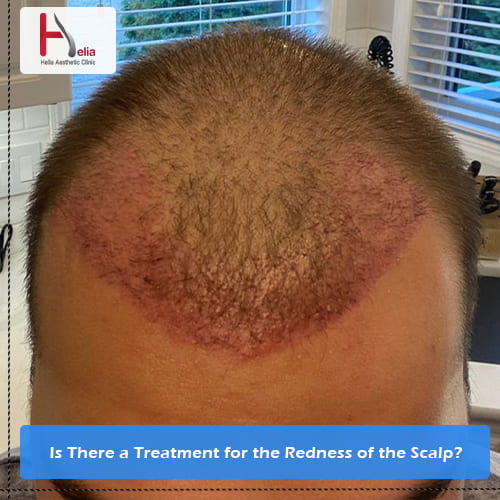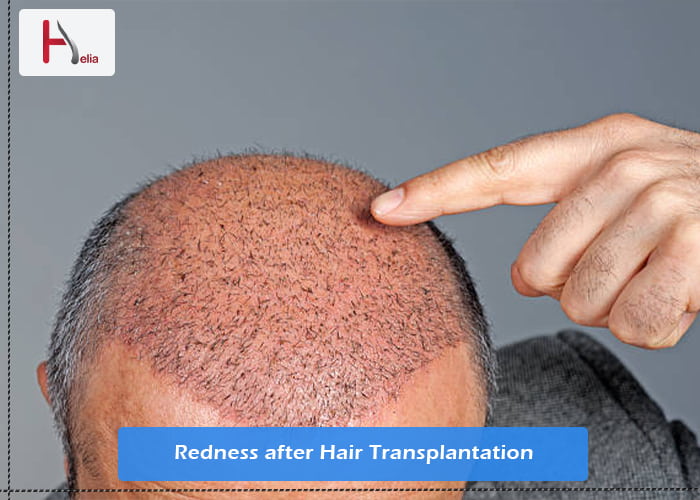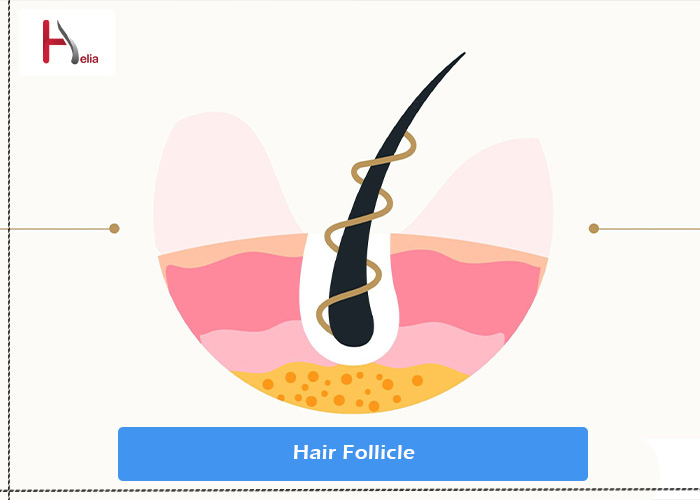Redness of the scalp after hair transplantation is a common problem that usually occurs in every person and disappears with time, but in some cases, it may require treatment. Redness of the hair transplant site can be seen both in the skin and in the scabs that form around the transplanted grafts.
One of the problems that many people, especially men, struggle with is hair loss. If a person suffers from the genetic disease of androgenic alopecia, over time, hair will fall out and lead to baldness, and this makes many people go for hair transplantation, one of the best and most guaranteed ways to solve baldness and hair loss problems.
The process of hair transplantation, due to the advances in recent years in all types of transplant methods, has become more modern day by day, increasing the speed, quality and success of the work, and reducing the number of side effects and the recovery period. However, hair implant applicants sometimes may face some side effects, however mild, such as the burning of the head after hair transplant or redness at the hair transplant site, which will improve over time if you pay attention to and follow the doctor’s instructions.
This article will help you to learn more about the redness of the scalp and its causes as well as ways to fix it, so stay with us until the end of the article.

What Are the Causes of Redness after Hair Transplant?
Redness of the scalp after hair transplantation is due to the implantation of hair follicles and the healing process after that. Since the surgery involves making small incisions in the person’s skin, these incisions begin to heal behind and around the newly transplanted hair. To promote healing, the body pumps blood to the surgical area, so the cells can receive more oxygen and nutrients and heal faster. This blood, which is due to more flow in the wound healing area, causes redness at the hair transplant site.
People with lighter skin have more obvious reddening of the scalp. But this redness of the skin happens to everyone, and the only difference is that it is more common in people with lighter skin. These symptoms usually last between one and three weeks.
In addition, as many tiny holes are opened in the donor and recipient area during the procedure and the roots are placed in their new holes, there may be crusting and scabbing. With the washing process, you may notice some redness in the recipient area or you may notice that your scabs become white and/or swollen.
What Are the Symptoms of Scalp Redness after Implantation?
Burning in the head after implantation is one of the signs of inflammation and is due to the readiness of the scalp and is caused by the surgery performed on the scalp. In fact, the cause of the pain and redness of the scalp is the reaction of the skin to the implantation and the wounds and grooves created by the doctor. In most people, two weeks after the surgery, the redness of the skin will be completely removed and the scalp will be restored. It is better to know that the amount of redness of the scalp after hair transplantation varies depending on the skin type and the color of the person’s head. Also, people with dark skin have less redness of their skin, but if the redness of the hair transplant site spreads, you should see a doctor because it is likely to be a sign of infection.
After a hair transplant, you should avoid touching the transplanted areas and you should not use the bathroom until you reach normal conditions. It is also suggested to rest at home to relieve head swelling and reduce or eliminate the redness of the hair transplant site.

Is There a Treatment for the Redness of the Scalp?
After hair transplantation, you should listen to the care and advice of the consultant and know that complications such as redness of the hair transplant site will be removed and the scalp will return to normal. To remove the redness of the scalp after hair transplantation, you must follow the instructions of the physician so that you do not have to worry about the redness and inflammation of the wounds and scars created.
Using ice compresses several times a day, and using a chair instead of a bed to sleep, not taking hot showers, not eating salty foods and having a healthy nutritious diet, avoiding smoking and alcohol for two weeks, wearing a hat while going out (no sunlight with the scalp directly exposed) and avoiding touching, rubbing and scratching the scalp in the implant area will speed up your healing process and be sure to visit your doctor once in a while and inform him about the condition.
In addition, by taking antibiotics, using warm water compresses and topical ointments, you can speed up the healing process of your scalp inflammation. You should also avoid arbitrarily taking medicines and ointments because it will disrupt your treatment and recovery process. In addition to the mentioned points, we should mention that the planting method can also affect the redness of the skin. Using the micrograft method does not have the side effects of other methods, such as redness of the head after hair transplantation and remaining scars. In addition, the hair bank is not harmed in the slightest.
Is It Normal to Have an Itchy Head after Hair Transplant?
Hair transplantation is done by making slits and holes in the hair donor area, which place the extracted hair follicle in the implantation site. Bleeding of these cracks and holes increases the blood supply to the wounds, which causes itching and burning sensation after a hair transplant.
Scalp redness and itching may last for several weeks or even months. Some people may experience burning of the head after hair transplantation along with swelling and bruising after the operation, and using an ice compress can help reduce this inflammation. Itching starts after one week and may last up to four weeks, after which it resolves. But if you wash your hair in the first days after transplanting, this complication may get worse. Itching and burning are usually resolved by themselves and are treated by following the health tips of the head area and taking medicines under the supervision of a doctor.
If itching persists after 2 weeks, you should see your surgeon. Itching can delay recovery and in some serious cases it can affect the results of hair transplantation and it can even be said that itching is the cause of pain and redness of the scalp after 4 weeks of transplantation.
What Factors Cause Greasy Hair after Hair Transplantation?
Oily scalp after hair transplantation is a completely natural process and various reasons can be mentioned for it. First of all, you should know that skin oil is considered a skin protection factor against external factors and pollution. The protective role of skin oil includes the prevention of skin dryness, skin regeneration, healing of wounds and maintaining the freshness of the skin after hair transplantation.
By producing oil, the scalp tries to increase the healing speed of wounds caused by cuts. Hair oil is considered a nutrient for hair. In addition to the fact that hair needs nutrients such as zinc, protein, vitamins and biotin, it also needs skin fat.
Usually, swelling occurs in the head area after hair transplantation, and the skin starts to secrete grease as a protective layer against skin swelling. Among the other reasons for the secretion of oil, we can mention the help for the implantation of newly planted hair, in which the role of skin oil is to maintain the elasticity of the skin and also help to the settlement of newly implanted hair.
Another reason for the greasy scalp is the presence of scabs that are formed on the head after the transplant operation, which help to breathe properly and improve the skin. The presence of these scabs will cause the accumulation of oil in the skin, and also the restriction of washing in the first few days after the operation is another reason for the increase of scalp oil.

Is Red Scalp after Hair Transplantation Dangerous?
Redness of the scalp after a hair transplant is a natural process as mentioned before and may last up to two weeks depending on the skin type. Redness of the skin after surgery will not affect the surgery.
However, the redness of the hair transplant site is not always due to the treatment and recovery process, and in rare cases, it can occur due to reasons such as folliculitis, cyst, cellulitis, or skin necrosis. In each of these cases, you must consult a specialist. Folliculitis, or hair infection, may cause redness of the scalp and last up to eight months. Folliculitis causes a yellow pus-filled sac and small red bumps. This complication is associated with symptoms such as heat, pain and itching, and the reason for its occurrence is a bacterial infection which is relatively common among people after hair transplantation.
Cellulitis or skin infection is caused by the attack of bacteria, and if a person gets cellulitis, the redness of the scalp gradually spreads and the person may feel pain and fever. Small swellings around the skin, or cysts, can occur both at the extraction area and the site of hair transplantation. Among the causes of cysts, we can point out that the planted hair does not come out or that the hair is not implanted correctly. This is where the importance of choosing an expert doctor becomes clear.
Another of the most important complications after hair transplantation is skin necrosis (dead or dying skin), which according to research is more dangerous than other complications. If the redness of the hair transplant site is due to skin necrosis, it is due to the poor skill of the doctor during the operation, and its symptoms appear two to four weeks after the hair transplant.
A person’s skin may also turn black or purple before symptoms begin. All the above cases cause redness of the scalp after hair transplantation, and if you encounter them, you should definitely visit your specialist.
If I have any symptoms related to skin redness after implantation, should I see a doctor?
One of the healing stages of any wound is the inflammatory stage. In this stage, inflammatory cells accumulate in the wound. Along with inflammation of the scalp, the amount of blood that supplies nutrients to this area increases. This is what causes the scalp to be red after a hair transplant.
Redness and any skin inflammation usually resolve after the first few weeks. However, some beauty seekers with lighter skin color may still have symptoms of inflammation and redness after hair transplantation, but fortunately, these conditions will eventually resolve on their own.
The redness of the scalp after hair transplantation varies depending on the patient’s body. This symptom usually disappears after one to three weeks. Of course, some applicants may experience redness of the scalp for a little longer. In the most severe cases, people with very pale or sensitive skin may experience redness for up to two months.
But if the redness after the hair transplant gradually increases or continues after more than 2 months, you should inform your doctor because your scalp may be infected. Your doctor may use medications such as weak steroid creams and other medications that help reduce skin inflammation and minimize, or eliminate scalp redness after a hair transplant.
Helia Dermatology Center is one of the best hair transplant and restoration centers that has advanced equipment and methods and operates in Dubai. If you have any kind of hair loss problem or need a hair transplant with methods such as micrograft, SUT, combined, etc., you can contact this clinic and get free advice from the center about the available methods and also the prices.




